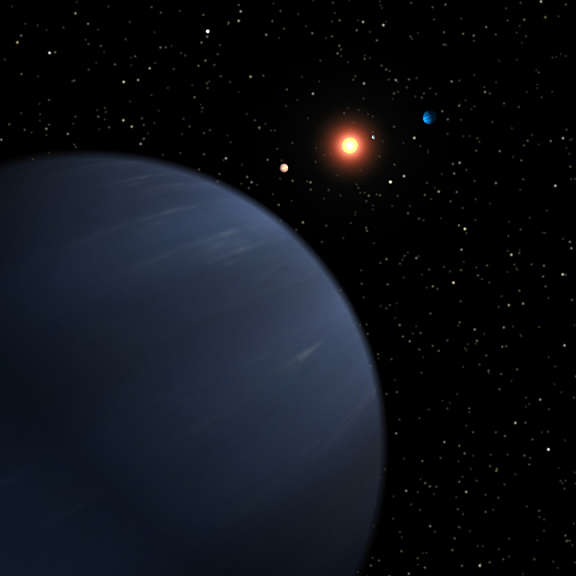All
All
Stories, updates, insights, and original analysis from The Planetary Society.
Jaded by Mars Organics
So, you may have heard the news making the rounds last week that a new analysis of the Viking data suggests there may actually be organics and (dare I even say it?) life on Mars! Yawn. Consider me underwhelmed.
New Pulsar Discovery Shows Power of Citizen Scientists and Planetary Society Members
Planetary Society members have reason to celebrate today, with the on-line publication in Science of the discovery of a new pulsar by three citizen-scientists working with Einstein@home, a descendant of the SETI@home project.
Optical SETI's Growing Capabilities
Often, the phrase “next steps” has been known to describe things that don't actually happen. But for The Planetary Society's All-sky Optical SETI, it's different. Here's what's happened in the last year.
Phobos Grunt including Phobos LIFE Delayed Until 2011
Today, the Russian space agency, Roscosmos, decided to delay from 2009 to 2011 the launch of the Phobos Grunt mission to study and return samples from the Martian moon Phobos.
Astropulse: A Fresh Look at the Skies in Search of E.T.
If you were a member of an alien civilization trying to communicate across the immeasurable distances of space, how would you go about it?
Dunes in the Outback Red Center
Jani talks about the importance of understanding analogs we can easily visit on Earth to processes happening across the solar system.
SERENDIP Takes a Great Leap Forward
Just when SETI@home is celebrating its 10th anniversary, its older brother, Project SERENDIP, is getting a general makeover.
Quake Catcher Network: SETI@home Spinoff Tracks Earth-Shakers
One of the youngest off-springs of SETI@home has been getting a great deal of attention recently. Known as the Quake-Catcher Network (QCN), this distributed computing project makes use of thousands of volunteers' computers to locate and track earthquakes.
From SETI@home to Hominid Fossils: Citizen Cyberscience Reshapes Research Landscape
In the beginning was SETI@home, the first large-scale volunteer computing project, launched in 1999 with seed money from The Planetary Society. Within months the project had millions of volunteers around the world joining to form the most powerful computer network ever assembled.
Planetary System Detected Around SETI@home Target Star
A fully formed planetary system, with five different planets of varying sizes and orbits has been found, orbiting a star more than 40 light years away. Significantly, it is the very same star, 55 Cancri, that was one of the chief targets of the SETI@home reobservations at Arecibo in March 2003.
Planetary Society's Optical SETI Telescope Offers Online View of Night sky
The Planetary Society's Optical SETI Telescope was built solely to search for possible light signals from alien civilizations. Located at Oak Ridge Observatory in Harvard, Massachusetts, it is the first dedicated Optical SETI telescope in the world. Its 72-inch primary mirror also makes it larger than any optical telescope in the U.S. east of the Mississippi river.
With Observations in Full Swing, Team Prepares to Remove "Sunglasses" from Telescope
Winter time is observing time at the Oak Ridge Observatory in Massachusetts, when humidity is low and the sky is often clear. And so it has been for the Optical SETI telescope, which opened its doors in April 2006.
Keeping an Ear to the Center of the Galaxy, Southern SETI Prepares for Great Leap Forward
Located in the southern part of the continent of South America, Southern SETI has a continuous view of densest star-fields in our galaxy. And, since 1990, it has been sponsored and supported by The Planetary Society.
Telescope Goes "Semi-Automatic"
Andrew Howard talks about the
With Multi-Beam Receiver, SETI@home Takes Giant Step Forward
In seven intense days spent at the radio telescope Chief scientist Dan Werthimer and his colleagues completely overhauled the way SETI data is gathered at Arecibo, and ensured that SETI@home will henceforth enjoy the benefits of gathering data with the most advanced equipment anywhere in the world.
Telescope shows its Amazing Capabilities
During a few observation sessions in late April, the new Optical SETI Telescope was already demonstrating its amazing capabilities. Over three nights, the telescope completed 17 hours of observation, under the direction of Paul Horowitz and his team of Harvard graduate students. During that time, the telescope observed 1% of the sky, looking for the briefest flashes of light coming from outer space.
Searching for E.T. and the Cure for Cancer:The Planetary Society Helps Trigger a Computing Revolution
Planetary Society members truly have helped pioneer new techniques in the conduct of science. Our initial investment has returned amazing results that will continue to deliver benefits over years to come.


 Explore Worlds
Explore Worlds Find Life
Find Life Defend Earth
Defend Earth


 Sun
Sun Mercury
Mercury Venus
Venus Earth
Earth Mars
Mars Jupiter
Jupiter Saturn
Saturn Uranus
Uranus Neptune
Neptune Small Bodies
Small Bodies





